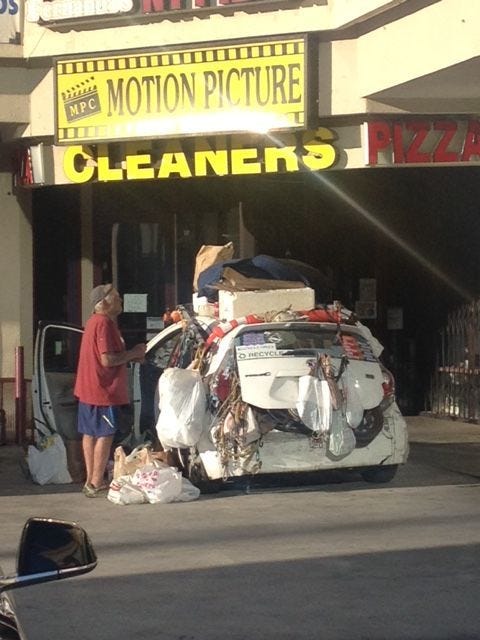Recession Tips: #5- Even more, even cheaper, housing ideas
A bunch more ways to pay less rent than the last "live cheap" post...
The point of this post is to give you some ideas of cheaper housing ideas, so none of you ever get to the point of living in your car like the guy above. The Bag Car, Studio City, California, 2021. #steveemigphotos
In my decades on this Earth, I’ve learned one thing about housing costs. No one ever seems to get around to actually creating “affordable housing” on a large scale. People say there’s a need for it. People agree it’s a good idea. People talk about it. But nobody actually gets around to actually building it.
The last “cheaper housing ideas” post included a bunch of ways to pay less rent than a typical, one bedroom apartment, for $2,500 a month or so, depending on your location. This post goes into a bunch of ways to live for less than a typical adult roommate situation, paying $800 to $1,000 a month for rent. These are potential housing options that don’t involve living with your parents, or being in a relationship. Relationships are nice, but when a break-up comes, someone has to move out. And sometimes one person’s belongings wind up on the front lawn, or other really bad scenarios. So these are options primarily for young (or just cheap), single adults, looking to save money on rent during this recession that no one wants to actually call a recession.
“Affordable housing” isn’t just something that homeless people need. College students need it. Young single people need it. Young couples need it. Families first starting out need it. Single parents with kids need it. A lot of retired people, and working people in their “golden years” need it. Artists, entrepreneurs, and people putting all of their focus into a creative or business project need it, while they’re getting their idea off the ground. Lots of people need “affordable housing,” at many different price points, at different times in their lives.
The reality is, developers keep building apartments to rent out at $3,000 a month or $4,000 a month, because the math doesn’t work to build apartments that rent for $500 a month. There’s not enough profit in “affordable housing,” pure and simple. When we head into an economic downturn or a recession, lots of people have to cut back on their monthly expenses. Housing is one of our biggest expenses. I’ve learned that when this happens, we have to look at the buildings that actually exist, houses, apartments, commercial buildings, whatever, and figure out our own ways to live on less money. So here are a bunch more potential ways to pay less for rent, and help you save money during this coming recession.
Cheaper than traditional roommates housing options:
Rent an apartment or house, and put two people in each bedroom. These can be either two friends, or a couple, in each room. During the recession of the early 1990’s, I lived in two of these situations, one I lived in twice. The average room rent with roommates then was $350 to $400 a month. In one of these places I paid $40 a week for a lower bunk bed, roughly $160 a month. In the other place, a four bedroom house full of hardcore BMX riders, we all paid $90 to $120 a month, depending on how many guys were living there that month, plus utilities. Both of those worked out pretty well for the incredibly low rent. Everybody should buy and cook their own food, and certain rules need to be created to keep chaos from happening. But these multi-person per room situations can work, if no one in the house is doing hard drugs.
Rent a 3 or 4 bedroom house or apartment, take the master bedroom, and put bunk beds in the other bedrooms. Rent out each bed by the week or month. Like I said above, I lived in a place like this with a bunch of strangers. It wasn’t ideal, but worked fine for close to a year. It’s smart to save up some money while in this type of situation.
Find a really cheap ADU (Additional Dwelling Unit), where the land owner just wants someone on the property, and isn’t worried about getting the top rental rate. I lived in an “unofficial” ADU once, a small room that a Latino family built on the side of their house, for $200 per month. There are some people in upscale neighborhoods, usually older people, who will rent out an ADU, pool house, or “mother-in-law” quarters, as they were once called. Some people just like to have a decent person living on the property to make them feel safer, and they’re not worried about getting high rent. You have to shop around, but you might be able to find a cool situation at a really good price.
Couch Tour- Sleep on a friend’s couch temporarily, in exchange for a cheaper rent payment. I’ve been “the guy on the couch” in one apartment in the early 1990’s recession, and slept on the floor of a one bedroom apartment (with two roommates), in another place. Again, it’s close quarters, and everyone should buy and cook their own food. Bathrooms can be an issue, a 1 1/2 or 2 bath place definitely helps. The key in the couch tour scenario is respect for the other people, and keeping your stuff packed up and neat, and keep the communal areas clean and neat.
Options for someone running a small business of some kind:
First, let me be completely clear, people are not supposed to live in a business unit, unless there’s an attached apartment and it’s zoned for both. Now, unofficially, in the 2020’s, we have tens of thousands of vacant commercial buildings, ranging from industrial units to small stores, to office spaces.
Why are there so many vacant and abandoned business buildings these days? That’s what my whole Simulpocalypse series of posts is about. Click the link to check out those posts. Living in a commercial building wasn’t really much of an option back in the 1990’s (or 2000 or 2008 recessions). The property owners of all these properties may be much more likely to “look the other way” these days, while someone is living in a commercial property now, because they just want some rent coming in. So many of these units are vacant, it’s a much different situation for building owners now. Use your discretion when talking to property owners. This will work best if you actually have some kind of legit small business in the unit, and if you personally know the property owner, as well.
Rent a small industrial unit- have 3 or 4 friends live there and share the rent. This is a long shot, but it is being done in places. Check out this video.
Rent a small industrial unit, run a legit small business in it, and live there. Check out this video as an example.
Rent a small store where you, run a small business there, and you live there. Or perhaps 2 or 3 people live there for less rent than a regular apartment.
Rent an office, run a legit small business there, and live there. Use the ideas above for how to do this successfully. I actually lived in an empty office, with the business owner’s permission, for a couple of weeks once. I would do some work in his business, next door, after hours. It wasn’t ideal, the one guy in the whole complex who worked late was in the unit on the opposite side, and he got all bent out of shape about someone being in the empty unit at night. But it worked for a couple of weeks, while I looked for other options.
Even cheaper options, moving into the beginning stages of homelessness
In my opinion, these options below qualify as forms of homelessness. In this post, I list 23 different levels of housing and homelessness, if you’re interested. I know from experience, I lived in my taxi for 5 1/2 years while working as a cab driver, and I’ve lived in several other “homeless” options, too. They’re cheap, but you can get stuck in these situations if you lose your steady source of income. That’s one way people become homeless for the long term.
Live in a camper or an RV parked on the side of somebody’s house. I lived in a large, toy hauler camping trailer (owned by a large business) for about a month once, parked behind the business, with their permission. That was pretty cool, actually, but I wasn’t able to find a job nearby. Ultimately, I wound up moving out of the area.
Live in a van, put your possessions in storage, and take showers at the gym. Read the book, or watch the movie Nomadland, it’s all about this type of living. It makes car living sound way too romantic. I read the book, which is a bit more down to Earth. Unfortunately, thousands of older people, people who should be able to be comfortably “retired,” live like this these days. I lived in both a full size taxi van, and a taxi minivan, for long periods of time. This sucks, but it is cheap.
Live in a car, put your possessions in storage, and take showers at the gym. I did this as a taxi driver. Living in your car is best done as a very short term thing, like when starting a new job, and waiting for those first couple of paychecks, or for a limited time period, to travel. Don’t get stuck in this lifestyle. It can be hard to escape.
See if there’s a “pod living” place somewhere in your city. Check out this video of a pod living place in Venice Beach, California.
Move to Slab City, in the Southern California desert, and build your own house. OK, don’t move to Slab City. But check out the video, you may want to go visit it sometime.
There you go, there are quite a few options to live for less than $1,000 per month, right now, in 2025, in today’s weird, and getting weirder, world. Use these ideas above as potential options, which will hopefully help you find the best scenario for your current situation in life. That’s the idea. Good luck.
There are no paid links in this post.
Recession Tips- #6- Coming soon…



